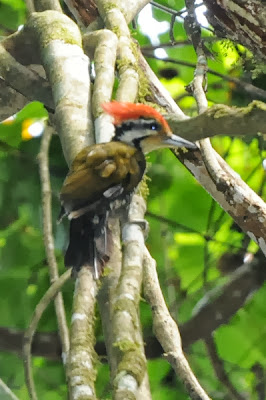Like all of the forest at Borneo Highlands, the area was rich in interesting and beautiful plants, including these magnificent clumps of Bird's-nest Fern (Asplenium nidus).
This appears (at least to my eye) to be a member of the Gesneriaceae.
These, I believe, are the fruits of a species of aroid.
Here is the stem of an understorey palm.
I have no idea what these are - I just like them!
The little speck on the trunk of this tree is a Black-eared Pygmy Squirrel (Nannosciurus melanotis) - my second encounter with this interesting little mammal.
As before, it seemed to spend most of its time hanging head-down - I don't know why.
However, this post is supposed to be about a bird walk (and I was with a very good birder), so I might as well get on with it. Unfortunately the forest where we walked was quite tall, and my opportunities for presentable photography were few. Here, however, is a Black-and-yellow Broadbill (Eurylaimus ochromalus), a favourite bird of mine whose shrill duets are a common forest sound. Seeing one can be another matter, though it is not particularly shy.
Barbets, though even more persistently vocal than broadbills, can be even harder to see. This Gold-whiskered Barbet (Megalaima haemacephala) provides a typical example of the view one usually gets, often at some risk to the birder's cervical vertebrae.
Daniel, however, found us a fairy low fruiting tree where we could watch Red-throated Barbets (Megalaima mystacophanos), strain-free and to our hearts' content. This is a male.
And here is the not-quite-but-almost-as-handsome female.
The bird of the day for me, though, was another neck-breaking canopy-haunter - but a lifer, which is why I am subjecting you to these less than satisfactory photographs. It is a male Olive-backed Woodpecker (Dinopium rafflesii), a Near-Threatened species dependent on primary forest. I just missed seeing one in Kubah National Park a few years back while in the company of David Bakewell, who did see it. Finding it up here was a surprise even for Daniel, though, as it is largely a lowland specialist. Is its move into the hills a sign of climate change?












++DSC_4564_resize.JPG)
++DSC_4565_resize.JPG)
++DSC_4567_resize.JPG)
+DSC_4531_resize.JPG)
+DSC_4519_resize.JPG)
+DSC_4535_resize.JPG)
+DSC_4542_resize.JPG)
+DSC_4545_resize.JPG)
+DSC_4548_resize.JPG)
+DSC_4550_resize.JPG)



No comments:
Post a Comment